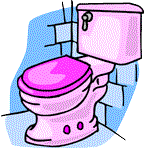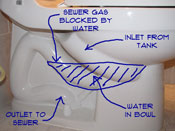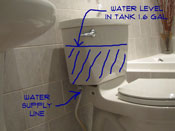 How a toilet works is some helpful information that you might want to know. Fixing a toilet is a little easier when you know about the basic operation.
How a toilet works is some helpful information that you might want to know. Fixing a toilet is a little easier when you know about the basic operation.
Not what you wanted? See 'How to Fix a Toilet' for all the toilet repair articles or 'Plumbing Repair' for all of the plumbing topics.
Toilets use water and pressure to flush. The pressure is created by gravity and pipe sizing. The water is stored in a tank until needed. When these two ingredients are properly balanced, the waste disappears and all is good.
Of course it is not quite that simple. The water needs to get into the toilet somehow. The tank needs to fill to a certain level. When the toilet is flushed the water needs to be released into the bowl. After all that, the tank needs to refill and be ready for the next time it is needed. All of these are related operations to the workings of a toilet.
Competition and government regulations have contributed to advancements in toilet technology. As time goes on, the functioning of toilets may change. For now, the basic operation is essentially the same as it was a few centuries ago. Does history interest you? See the article 'The History of the Toilet', for the exciting story of the development of the toilet.
How a Toilet Operates
 A toilet operates by allowing a large amount of water into the bowl quickly. This creates a siphon action that literally sucks the water and waste out of the bowl.
A toilet operates by allowing a large amount of water into the bowl quickly. This creates a siphon action that literally sucks the water and waste out of the bowl.
For toilet repair topics, see 'How to Fix a Toilet' or 'Home Plumbing Repair'.
To say that a lot of engineering goes into making that work, would be an understatement. Not only do you want the waste to go away, but well designed toilets also rinse the bowl out when it flushes.
Toilet Plumbing
A toilet is connected to a household plumbing line that connects to the sewer at the street or a septic system. To keep from getting fumes back into your house, a toilet has a trap built into it. The pipe that goes through the base of the toilet is sort of 'S' shaped.
The shape of the trap insures that there is always water in the bowl. The water blocks the foul smelling air that would otherwise escape from the sewer line. Worse than 'foul smelling' sewer gas can be dangerous, that is why all plumbing devices in your home have a trap.
The Toilet Tank
The toilet tank stores a supply of water that is released quickly into the bowl when the toilet is flushed. When the water level in the tank is lowered the toilet fill valve engages refilling the tank. The fill valve has a float on it that shuts the valve off when the tank is at the proper level.
Toilets use a lot less water than they used to. This is driven by an effort to cut down on fresh water usage. See the article 'Toilet Water Usage' for more information. The government has imposed restrictions on how much water a toilet is allowed to use for each flush.
Toilet Flappers
The toilet flapper along with the flush valve is the part that releases the water into the bowl. The flapper lifts up when you engage the handle and allows all of the water in the tank to escape in a few seconds.
The flush valve has a short sectin of pipe with seals on it that provides a passageway from the tank to the bowl. In one piece toilets this may be part of the casting.
The Flushing Action
Gravity and the design of the inlet into the bowl create water pressure that is directed toward the outlet side of the trap. The rushing water creates a siphon effect that sucks the balance of the water and any waste out through the trap.
How a toilet works is controlled by the siphonic action of the water rushing through the trap. Gravity and water pressure are the two main factors. This is, of course, a simple explanation. Engineers that are working on toilets will say it is much more complex. The truth is that toilets have been in use for the last few centuries and a lot of improvements have been made over time. Yet, the basic functioning of a toilet has not changed that much.
Toilet Water Usage
 Toilets use water, so there is an expense for every flush. Obviously, toilets that use less water are desirable.
Toilets use water, so there is an expense for every flush. Obviously, toilets that use less water are desirable.
For toilet repair topics, see 'How to Fix a Toilet' or 'Home Plumbing Repair'.
Laws Concerning Toilets
In the past several years, the main focus has been on how much water a toilet uses. Since 1992 it has been a requirement that toilets use no more than 1.6 gallons per flush. This posed a problem for manufacturers, requiring major design changes.
Prior to that time toilets typically used 3.5 gallons. That was considered a 'water saver' style. Down from 5 and 7 gallons in decades gone by. In the beginning of this overhaul, they did little more than change the water level in the tanks.
Water Usage Developments
The first 1.6 gallon flush toilets did not work well at all. When the laws were first implemented, manufacturers did little more than lowering the level in the tank. With less water in a bowl designed for more, the toilets flushed poorly.
Many times the toilet would have to be flushed more than once. Flushing the 1.6 gallon toilet two or three times effectively defeated the purpose of lowering the water level.
In addition, the toilets clogged often. Clearing away a clog and then cleaning up afterward was not what people wanted.
Homeowners complained about the aggravation and mess. Steps were taken to make improvements. Engineers had to evaluate how a toilet works with the new standards in mind.
Improvements Over Time
Over time, engineers came up with better designs that flushed properly and did not clog using the 1.6 gallon requirement. The newer designs do a pretty good job on both flushing and water usage. Engineers were inspired by this and have now come up with toilets that use even less water.
There are toilets available that have a water usage of 1.2 gallons and only .8 gallons for liquids. This style of toilet makes use of pressure assist technology and tend to cost more than conventional toilets.
You will need to be the judge of whether these toilets are worth the extra money. Check out the reviews before you purchase this style to make sure the performance will be acceptable.
Common Toilet Repairs
With the new toilet designs, you might think that toilets are now problem free. They do have fewer problems than they used to, but they are not problem free.
For toilet repair issues, see the article 'How To Fix a Toilet'. For all plumbing problems you can review 'Home Plumbing Repair'.
Maintenance and repairs are still required from time to time. A clogged toilet is still a possibility. Foreign objects and too much volume can account for this. Toilet clogs are a dreaded occurrence, however, they can be taken care of quickly.
Toilets use water to operate. This means that leaks are a possibility. A toilet actually has several places that it can leak from. That is a little discouraging. Fortunately, when properly installed, leaks on a toilet are not that common.
Internal components like the 'toilet fill valve' and the 'toilet flush valve' can cause problems. Both of the devices control the water in the toilet. They are inexpensive parts and can be replaced.

